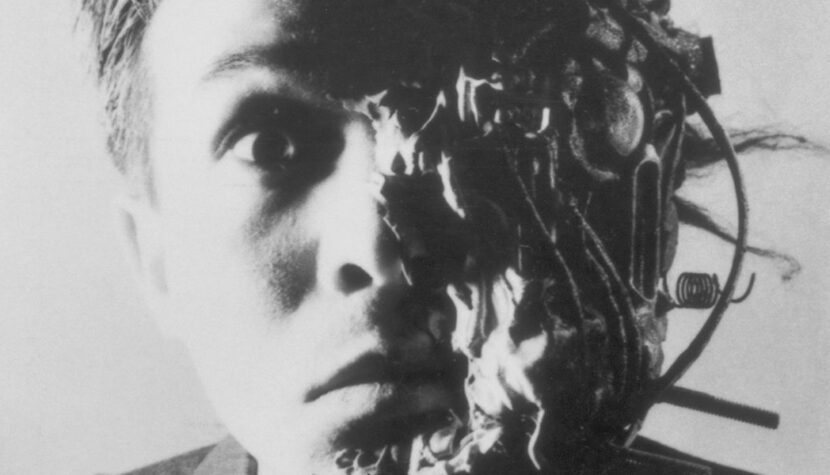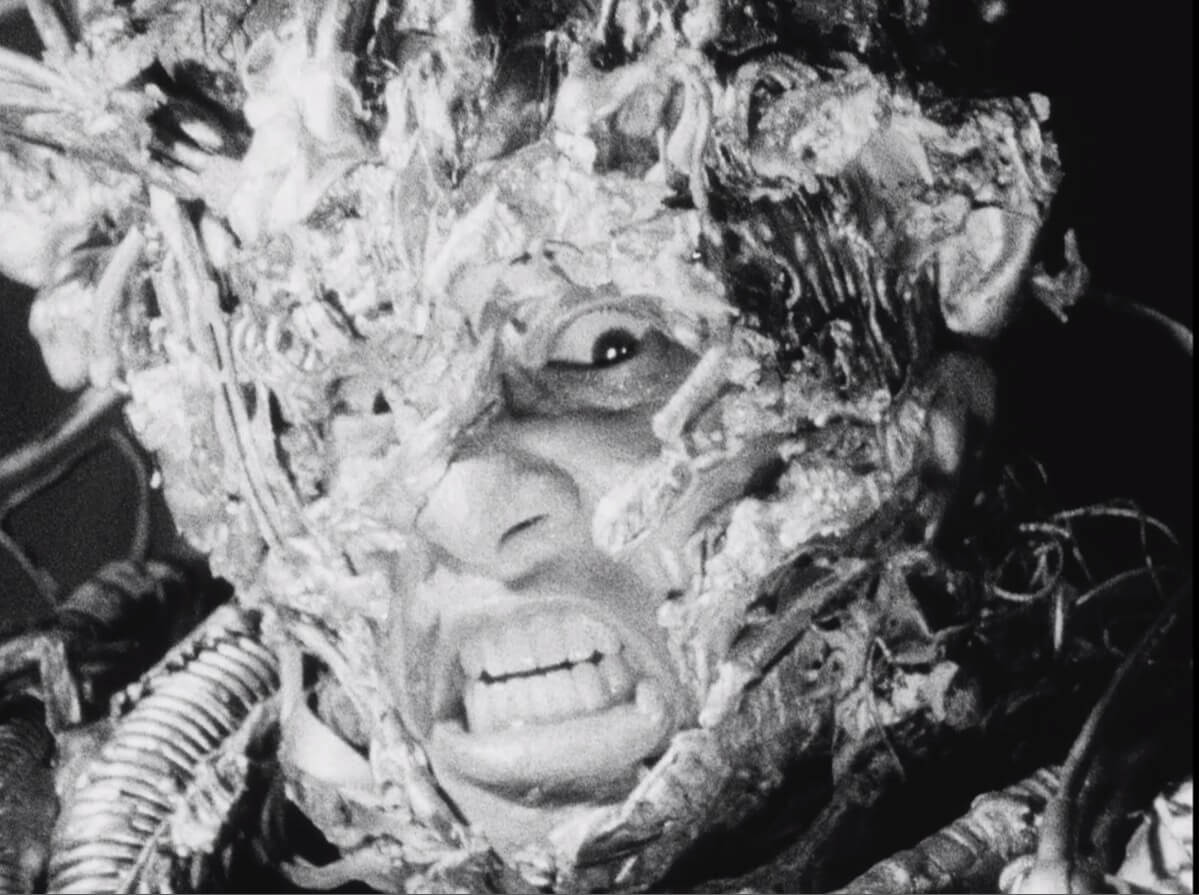TETSUO: THE IRON MAN. Cyberpunk macabre

Unidentifiable emissions float in the air, the fan operates sluggishly, not so much unable as unwilling to cleanse the air filling the claustrophobic interior of an industrial ruin. The room must be hot and humid. Beads of sweat cover the man, soon mixing with blood oozing from a gash on his thigh. At this stage of the story, we are not dealing with a crime. The body is intentionally torn apart by the man himself. It is opened to insert a metal rod, which he earlier dragged with perverse pleasure across clenched teeth. Immediately after this act of vandalism on human flesh, the frame is filled with burning photographs. Images of sculpted athlete bodies turn to dust. Is it time for a change in the canon? Replacing metaphorical muscles of steel with real feet of resilient metals? This is how Tetsuo: The Iron Man, directed by Shinya Tsukamoto, begins.
Surrealism, cyberpunk, music video, and body horror
The Japanese filmmaker’s work saw the light of day in the late 1980s, a year before the dawn of a new decade. Cyberpunk from the Land of the Rising Sun was no longer an entirely fresh concept, known only to a handful of the most dedicated enthusiasts. Prior to Tsukamoto, trailblazers like Sogo Ishii with Burst City (a punk rock tale of a gang opposing the construction of a nuclear power plant in Tokyo), Shigeru Izumiya with Death Powder (a story of scientists stealing an advanced android from a laboratory), and Katsuhiro Otomo with the animated Akira, which I wrote about just a few days ago, had paved the way. However, Tetsuo: The Iron Man is by no means a derivative film; quite the opposite. It’s a completely wild picture that mixes elements characteristic of surrealism, cyberpunk, music videos, and body horror. Moreover, it’s enriched with a substantial dose of dark and perverse humor that, considering the visual aggression of the narrative, can leave the viewer utterly stupefied.

The man inserting an iron rod into his own tissues is just the beginning of Tsukamoto’s disturbing vision. Tetsuo: The Iron Man lasts a little over an hour, and with each passing minute, the invasion of metal into the bodies of the main characters intensifies. Pieces of sheet metal, twisted wires, drills, and aluminum pipes take over their bodies like organic growths accompanying the most terrifying skin diseases. In most cases, we witness the bodily mutation of a Japanese businessman who initially tries to fight the changes occurring within him. He starts by removing small pieces of metal, hiding them under tight bandages. Then comes the phase of nervous breakdown, attempting to isolate himself from loved ones (his wife/girlfriend living with him in a small apartment). Ultimately, the mutation also encompasses his brain. The character gradually begins to lose his identity and transform into a monster that derives perverse pleasure and the strength to continue from the entire process. “Ah… I feel great,” whispers the terrifying hybrid formed by the merging of the mutated bodies of the businessman and the man from the film’s prologue. What a contrast to the scene where the cowering businessman hides from his spouse and refuses to open the door out of shame for his appearance and fear of her reaction.

Tsukamoto’s film might appear as a macabre music video, where the director is solely concerned with creating compositions based on various metal variations. On this most basic level, Tsukamoto’s vision could indeed be perceived as a surrealist installation combining grotesque sculpture with aggressive electronic music by Chu Ishikawa (the musical layer plays an incredibly important role in Tetsuo, and Ishikawa does an outstanding job). However, the method lies within the madness. His Tetsuo: The Iron Man touches on many issues that constitute the foundation of the identity of Japan from that time. The same fear of tomorrow that I wrote about in the context of Akira. The ambivalence regarding technological advancement, which, on the one hand, elevates human greatness, but on the other, increasingly threatens humanity. Ultimately, there’s the fear of blurring the boundary between human and artificial, the fall of individual humans in favor of collective momentum towards destruction. Tetsuo’s ending underscores that the “new man” will want to shape the world in his own image, inevitably leading to the destruction of everything we’ve built so far. In the case of Tetsuo, it’s a submersion in metal.
Tetsuo: The Iron Man and the virus
Spiritually, Tsukamoto’s film is a classic realization of cyberpunk anxieties. What sets it apart from other stories is that in the world of metal fetishists, it’s not the machines created in the likeness of humans that become emancipated—such a vision is, after all, more human and easier to accept. In Tetsuo, it’s the scraps of metal themselves that suddenly behave like a deadly virus. It’s the material that enables the great technological revolution that begins to emancipate. However, the virus lacks a moral system, higher motivations; it doesn’t hold a white dove in its hand and doesn’t utter words that remind us that a machine can be more human than a human. The virus wants to live, eat, consume, spread, and destroy. And it’s precisely this primitivism that makes it terrifying.

Wounding the viewer
The convention adopted by Tsukamoto fits perfectly with conveying this type of terror. Tetsuo: The Iron Man remains memorable mainly because it literally wounds the viewer with its imagery, attacking like a metallic disease gnawing at the wounds of the film’s characters. Aggressive editing, surrealistic set design, and costumes that, despite the limited budget and the passage of time, still leave an impression—combined with the overexpressiveness of the actors deepening the sense of madness—all of this, amplified by the industrial sounds created by Ishikawa, turns the monstrous mutation into a piece of art that infiltrates our consciousness, much like the metal rod appearing in the film’s prologue. The brain screams to stop, eyelids sometimes categorically demand closure, yet we want to look and, in a way, continue inflicting pain on ourselves because there’s a bit of a cinematic masochist in each of us.

I respect Tetsuo precisely because it can unleash that perverse element in a person that compels them to look nonetheless. And it’s not solely about morbid curiosity, characteristic perhaps of engaging with gore. Tsukamoto captivates the viewer with an artistic vision, on-screen madness that transforms into a metaphor for specific fears and anxieties in their hands. It might seem that there’s nothing more repulsive than observing human mutations, witnessing developing diseases. The Japanese director proves that even in this process, one can discern, albeit amidst the deformity, an enduring beauty—though, in the context of Tetsuo, this word is truly hard to swallow.

